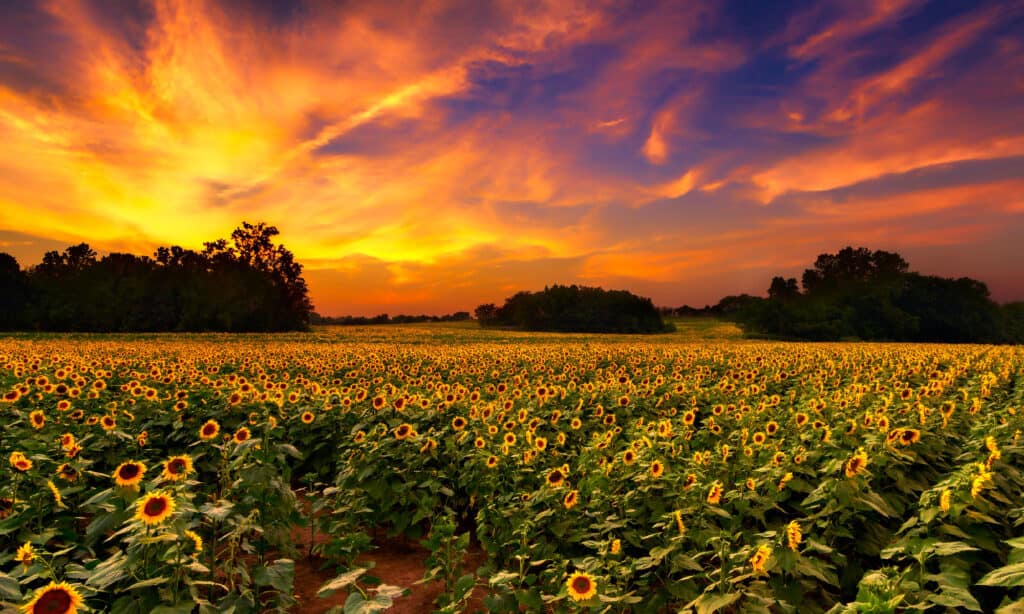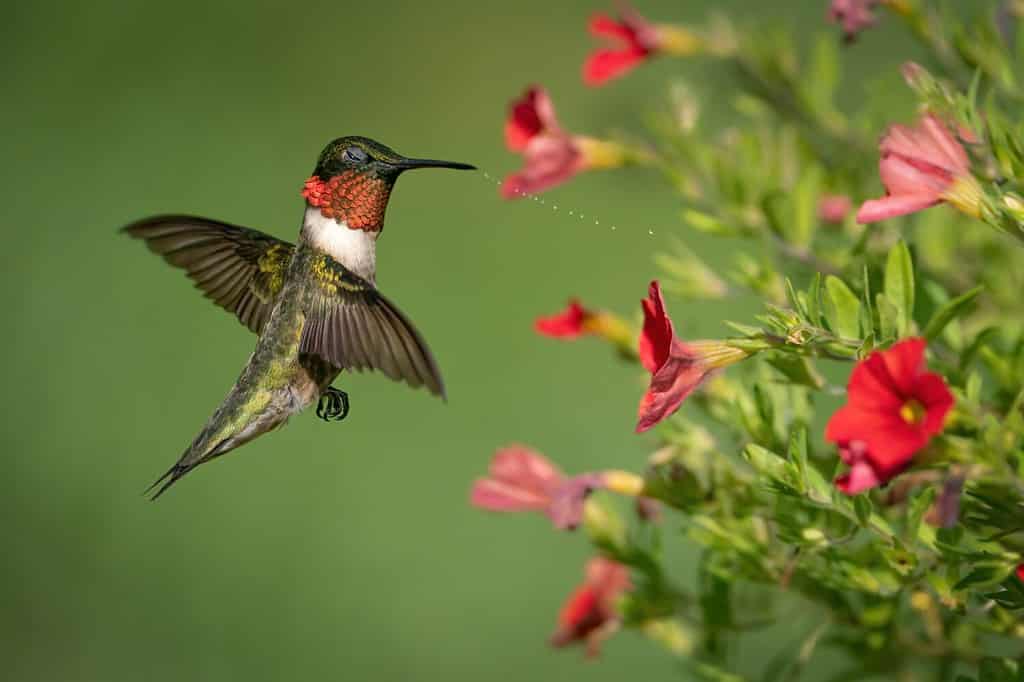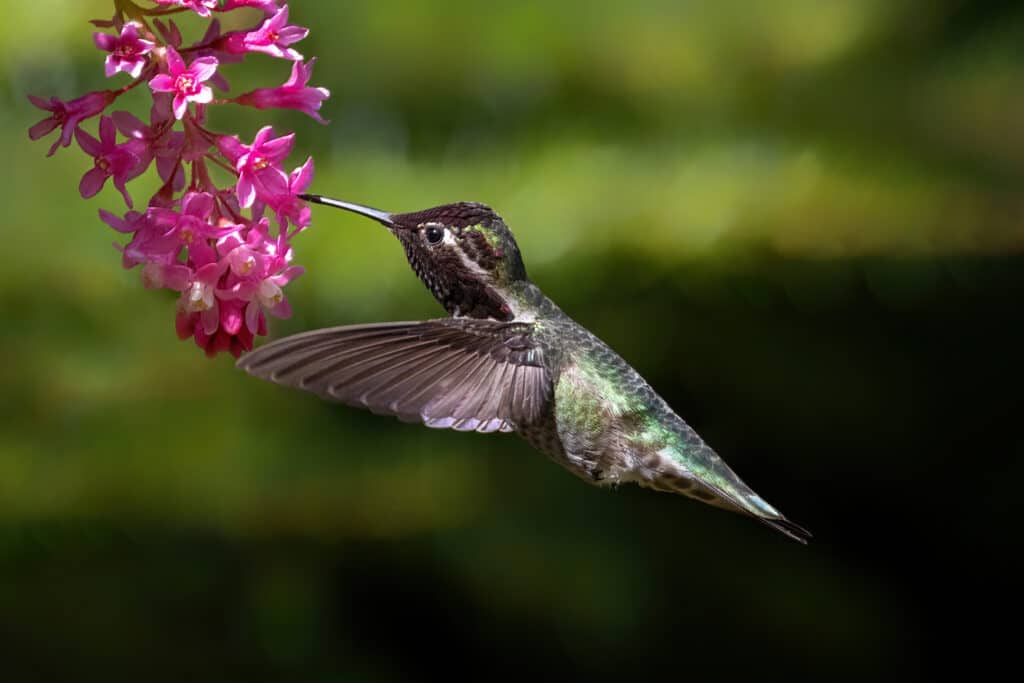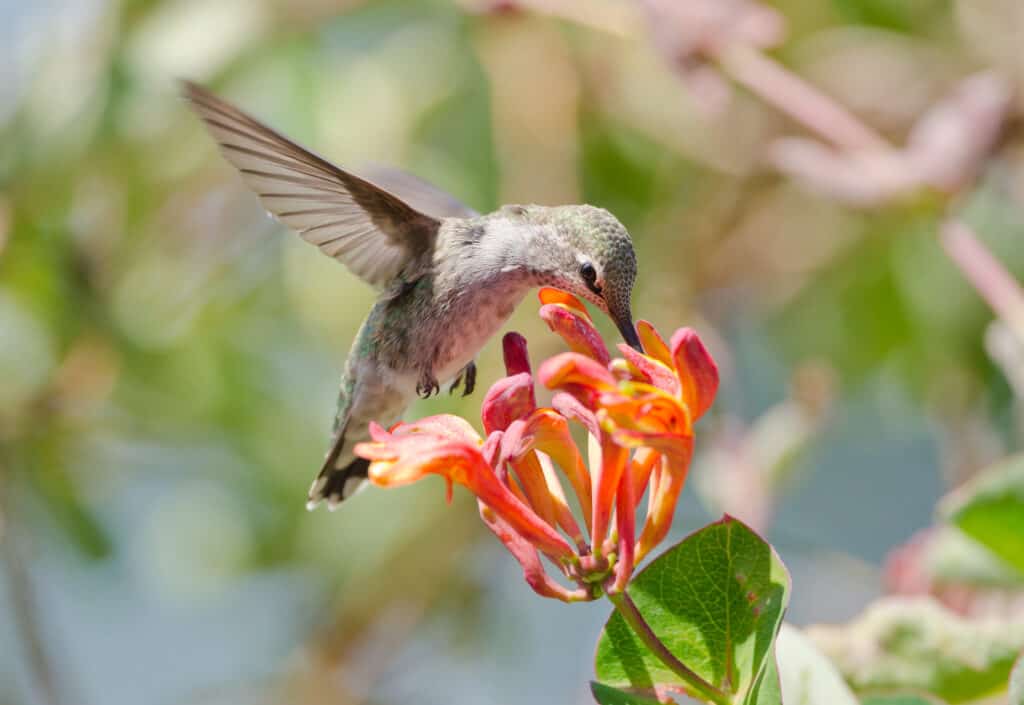Hummingbirds are the smallest bird that migrates. Unlike other bird species, they travel alone rather than in flocks. Not only are they fascinating to watch with their iridescent feathers and quickly moving tiny bodies, but they are also beneficial to gardens. Hummingbirds are excellent pollinators, and they will help rid yards of pesky insects.
Eight species of hummingbirds have been spotted in Kansas based on sightings reported on the Cornell Lab’s allaboutbirds.org website. However, the ruby-throated hummingbird is by far the most common. A migratory bird, they aren’t found in the state year-round. Read on to find out when is the best time to spot these tiny birds, and when hummingbirds leave Kansas.
Discover When Hummingbirds Leave Kansas

Hummingbirds live in the Sunflower State during the warm summer months, leaving in the fall when the weather cools.
©iStock.com/tomofbluesprings
Hummingbirds migrate to Kansas during the warm, summer months. They arrive in the spring and leave in the fall as the weather begins to cool. Hummingbirds typically leave Kansas in October, although you may spot a few stragglers in the state through November.
Read on to learn about the eight species of hummingbirds you may see in Kansas, where they migrate to, and when and where you may encounter them.
Ruby-Throated Hummingbirds

Ruby-throated hummingbirds are the most common in Kansas and are attracted to red or orange tubular flowers.
©Cavan-Images/Shutterstock.com
The ruby-throated hummingbird is a bright emerald green bird with a white underside. Tiny birds, they grow to be about seven to nine centimeters long with up to an 11-inch wingspan.
According to the Kansas Department of Wildlife and Parks, ruby-throated hummingbirds start arriving in Kansas in the spring, typically mid-April. They remain in Kansas until October, when they migrate south to the Gulf Coast, Mexico, Panama, and Yucatan. Ruby-throated hummingbirds are abundant in the eastern half of the state during their migration period, but less commonly sighted in western Kansas.
Rufous Hummingbird

Rufous hummingbirds can sometimes be spotted in western Kansas during their migration.
©Keneva Photography/Shutterstock.com
The male of the species can be identified by its orange feathers and throat, while the females are green with speckled throats. They spend their summers in Canada and the Pacific Northwest, then migrate as far south as southern Mexico.
The rufous hummingbird is typically seen in the western United States, however, sightings have been reported sporadically throughout Kansas.
Black-Chinned Hummingbirds

When the light hits the bird a certain way, a vibrant purple bow can be seen around their necks.
©rck_953/Shutterstock.com
These little birds can be identified by an iridescent purple bow around their black necks, seen only when the light reflects in just the right way. Black-chinned hummingbirds breed in the western United States and migrate south to Mexico and Central America for winter. Although not common, black-chinned hummingbirds have been sighted in western Kansas from time to time.
Rare Hummingbirds for Kansas

Though rarely found in Kansas, Anna’s hummingbirds are sometimes seen in the state.
©iStock.com/Devonyu
These five hummingbirds have made appearances in Kansas, but seeing them in the state is likely to be very rare. They are the following:
- Costa’s hummingbird (short-distance migrators, live year-round in southern California)
- Broad-billed hummingbird (short distance migrators, travels from southern Arizona to Mexico)
- Anna’s hummingbird (doesn’t migrate, can be found year-round from California to British Columbia)
- Broad-tailed hummingbird (migrates from western U.S. and Canada to southern Mexico and Guatemala)
- Calliope hummingbird (migrates from California and British Columbia to the Southwestern United States, Mexico, and Central America)
How to Attract Hummingbirds to Your Kansas Garden
Hummingbirds use a massive amount of energy to feed their high metabolic rate. They feast about every ten minutes, eating half of their body weight in insects and nectar daily. To prevent them from starving during the night when they are not feeding, their bodies go into a temporary hibernation where their heart rate lowers drastically.
If you’re interested in attracting hummingbirds to your Kansas garden, there are several ways you can make your outdoor space inviting to the tiny birds.

A hummingbird feeds on an orange honeysuckle flower.
©Birdiegal/Shutterstock.com
Plant Vibrant Flowers
One of the best ways to bring hummingbirds to your yard is to plant flowers that hummingbirds love. Hummingbirds prefer vibrant red and orange flowers with tubular shapes that contain lots of nectar.
Some Kansas flowers that will help attract hummingbirds include:
- Columbine
- Coral bells
- Lilies
- Salvia (sage)
- Bee balm
- Phlox
- Trumpet vine
- Trumpet honeysuckle
- Red cardinal flower
- Lupine
- Rose of Sharon
- Zinnias
Hang a Hummingbird Feeder
Hang your feeder from spring to fall, when hummingbirds are likely to pass through. You can buy pre-made hummingbird food, or make your own. Be sure to keep your feeder clean. Hummingbirds will avoid spoiled food.
Provide a Water Source
Hummingbirds need fresh water to drink and bathe in. A freshwater source in your garden will help attract hummingbirds, and other wildlife as well. Hummingbirds particularly enjoy misters and fountains, with fresh running water.
Plant Trees and Shrubs
Hummingbirds need a place to take shelter and perch. They won’t be interested in a plain, tree-less yard. Trees and bushes also provide shelter for other birds and wildlife.
Don’t Use Pesticide
Hummingbirds will come to your garden to eat your insects. Pesticides will eliminate bugs, and pesticides can harm hummingbirds and other beneficial pollinators as well.
Deadhead Your Flowers
By deadheading dying flowers, you help your plants have new growth, which will attract pollinators (including hummingbirds) to your garden.
The photo featured at the top of this post is © Bonnie Taylor Barry/Shutterstock.com
Thank you for reading! Have some feedback for us? Contact the AZ Animals editorial team.







